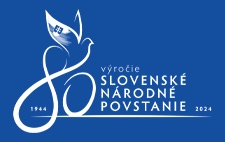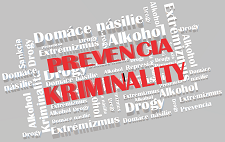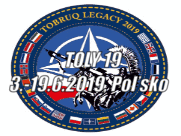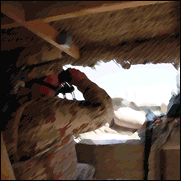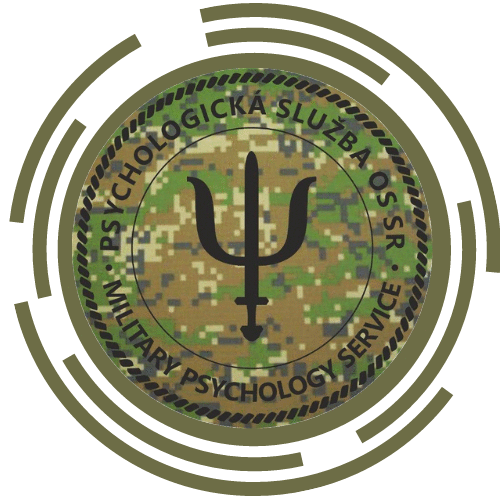General information
General information about Slovakia and Bratislava
The Slovak Republic (short form: Slovakia /sloʊˈvɑːkiə/; Slovak: Slovensko, long form Slovenská republika) is a landlocked country in Central Europe with a population of over five million and an area of about 49,000 square kilometres (19,000 sq mi). Slovakia borders the Czech Republic and Austria to the west, Poland to the north, Ukraine to the east and Hungary to the south. The largest city is its capital, Bratislava. Slovakia is a member state of the European Union, NATO, UN, OECD, WTO, UNESCO and other international organizations.
Slovak landscape and culture
The Slovak landscape is noted primarily for its mountainous nature, with the Carpathian Mountains extending across most of the northern half of the country. Amongst these mountain ranges are the high peaks of the Tatra Mountains. To the north, close to the Polish border, are the High Tatras which are a popular skiing destination and home to many scenic lakes and valleys as well as the highest point in Slovakia, the Gerlachovský štít at 2,655 metres (8,711 ft), and the country's highly symbolic mountain Kriváň.
Major Slovak rivers are the Danube, the Váh and the Hron. The Tisa marks the Slovak-Hungarian border for only 5 km.
Cityscape and architecture
The cityscape of Bratislava is characterized by medieval towers and grandiose 20th-century buildings, but it has undergone profound changes in a construction boom at the start of the 21st century.
Michael's Gate 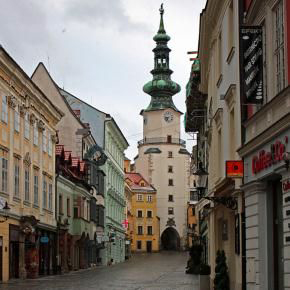 is the only gate that has been preserved from the medieval fortifications, and it ranks among the oldest of the town's buildings; the narrowest house in Europe is nearby. The University Library building, erected in 1756, was used by the Diet of the Kingdom of Hungary from 1802 to 1848. Much of the significant legislation of the Hungarian Reform Era (such as the abolition of serfdom and the foundation of the Hungarian Academy of Sciences) was enacted there.
is the only gate that has been preserved from the medieval fortifications, and it ranks among the oldest of the town's buildings; the narrowest house in Europe is nearby. The University Library building, erected in 1756, was used by the Diet of the Kingdom of Hungary from 1802 to 1848. Much of the significant legislation of the Hungarian Reform Era (such as the abolition of serfdom and the foundation of the Hungarian Academy of Sciences) was enacted there.
Bratislava Castle
One of the most prominent structures in the city is Bratislava Castle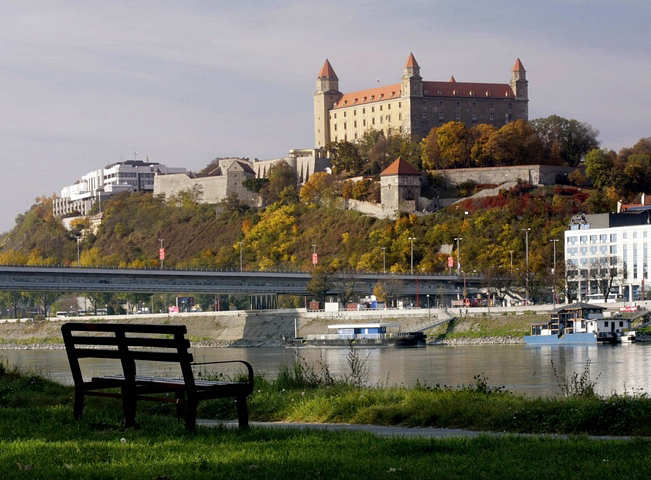 , on a plateau 85 metres (279 ft) above the Danube. The castle hill site has been inhabited since the transition period between the Stone and Bronze ages and has been the acropolis of a Celtic town, part of the Roman Limes Romanus, a huge Slavic fortified settlement, and a political, military and religious centre for Great Moravia. A stone castle was not constructed until the 10th century, when the area was part of the Kingdom of Hungary. The castle was converted into a Gothic anti-Hussite fortress under Sigismund of Luxemburg in 1430, became a Renaissance castle in 1562, and was rebuilt in 1649 in the baroque style. Under Queen Maria Theresa, the castle became a prestigious royal seat. In 1811, the castle was inadvertently destroyed by fire and lay in ruins until the 1950s, when it was rebuilt mostly in its former Theresan style.
, on a plateau 85 metres (279 ft) above the Danube. The castle hill site has been inhabited since the transition period between the Stone and Bronze ages and has been the acropolis of a Celtic town, part of the Roman Limes Romanus, a huge Slavic fortified settlement, and a political, military and religious centre for Great Moravia. A stone castle was not constructed until the 10th century, when the area was part of the Kingdom of Hungary. The castle was converted into a Gothic anti-Hussite fortress under Sigismund of Luxemburg in 1430, became a Renaissance castle in 1562, and was rebuilt in 1649 in the baroque style. Under Queen Maria Theresa, the castle became a prestigious royal seat. In 1811, the castle was inadvertently destroyed by fire and lay in ruins until the 1950s, when it was rebuilt mostly in its former Theresan style.
River
The Port of Bratislava is one of the two international river ports in Slovakia. The port connects Bratislava to international boat traffic, especially the interconnection from the North Sea to the Black Sea via the Rhine-Main-Danube Canal. Additionally, tourist lines operate from Bratislava's passenger port, including routes to Devín, Vienna and elsewhere.
Weather data for Bratislava
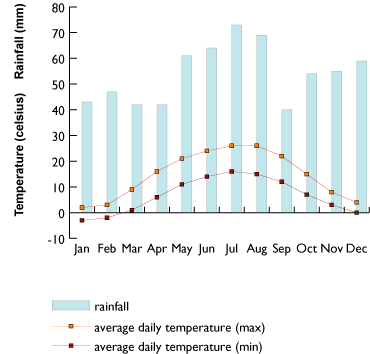
Passport or an identity card, if necessary a valid visa for the whole stay is indispensable to enter Slovakia. Participants who need a compulsory visa should apply for it in time at the respective authorities in their country.
Time zone
Slovakia is situated in the Central European Time Zone, UTC/GMT + 1 hour.
Currency
The national currency is the Euro (€). Credit cards (VISA, MasterCard, American Express) are widely accepted in hotels, shops and restaurants.
Insurance
Each delegate is responsible him- or herself to arrange for health and travel/annulation insurance. The organising committee declines all responsibility for accidents, illness or damage occurring during the meeting.
Links
Weather
Skočiť na menu
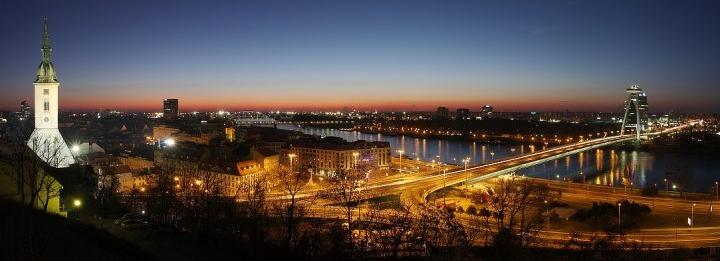
 is the only gate that has been preserved from the medieval fortifications, and it ranks among the oldest of the town's buildings; the narrowest house in Europe is nearby. The University Library building, erected in 1756, was used by the Diet of the Kingdom of Hungary from 1802 to 1848. Much of the significant legislation of the Hungarian Reform Era (such as the abolition of serfdom and the foundation of the Hungarian Academy of Sciences) was enacted there.
is the only gate that has been preserved from the medieval fortifications, and it ranks among the oldest of the town's buildings; the narrowest house in Europe is nearby. The University Library building, erected in 1756, was used by the Diet of the Kingdom of Hungary from 1802 to 1848. Much of the significant legislation of the Hungarian Reform Era (such as the abolition of serfdom and the foundation of the Hungarian Academy of Sciences) was enacted there.



